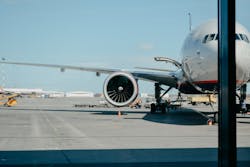How Video Surveillance Technologies Are Changing the Way Airports Operate
Airports are among the busiest locations on the planet. At any given moment, there might be thousands — even tens of thousands — of people present inside an airport, boarding flights, departing flights, grabbing a bite to eat, or just killing time before they depart. Most people at an airport have just one goal in mind: to get to their destination safe and sound — and on time.
As the travel restrictions imposed amid the COVID-19 pandemic begin to relax, travelers are ready to get back in the air. This will significantly impact already-busy airports — travelers are ready to spend money on vacations and return to “normal,” making up for the last few years of quarantine with a flurry of travel-related expenditures. Airports — and airline employees — must be ready to handle this influx of passengers, even as staff shortages and precarious viral outbreaks may continue to loom. Fortunately, new and emerging surveillance technologies have allowed airports to leverage additional operational capabilities that are helping to keep things running smoothly in the face of adversity.
Leveraging Improved Technology
The increase in air traffic is very real — in 2022, global air traffic volume is expected to exceed 3.4 billion passengers. While this is still down from pre-pandemic levels, it is roughly a 50 percent increase over the 2.2 billion passengers who traveled by air in 2021. As the demands continue to increase, airports are considering how to manage the increased volume as efficiently as possible. Security teams at many of the globe’s most forward-thinking airports now recognize that surveillance technology like internet protocol (IP) cameras equipped with advanced analytics can play a role that goes well beyond traditional security measures. In fact, many users of the video system are of non-security-related functions including operations, maintenance and others. The vital surveillance role these devices play helps improve the overall traveler experience in three ways: it can drive efficiency, increase profitability and — even in the face of lengthening queues — assist with creating a better passenger journey.
Before the invention of the IP camera, surveillance devices had limited utility in airports, serving primarily to help investigate crimes after the fact. True, a security team member might notice a significant commotion occurring on a bank of wall monitors, but in general, the technology was reactive rather than proactive. Continuous advances in camera technology have changed this. Not only has image quality improved dramatically over the past decade, but chipsets have also become more advanced, increasing processing power and enabling these devices to run analytics applications natively at the network edge. Thanks to today’s AI capabilities, data can now be aggregated and analyzed on the devices themselves, sending relevant metadata to cloud servers and decreasing the amount of bandwidth and data storage needed to operate. This has made modern analytics solutions significantly more accessible and allowed airports to handle larger deployments of cameras with vastly improved capabilities.
Among the new abilities the technology has enabled are immediate alerts that are more suitable for real-time operations. Today’s AI-enabled IP cameras are better than ever at tasks like object recognition, motion tracking and more. They can be trained to issue alerts when certain conditions are met—such as trespassers in a restricted area, a vehicle traveling in the wrong direction, or aggressive or violent behavior within the terminal. By raising an alarm as soon as suspicious or offending behavior is detected, this technology can dramatically decrease response times and even allow potentially dangerous incidents to be stopped before they can escalate.
While this technology has its roots in security, it has also enabled airports to optimize their operations at the speed at which situations happen when they happen. Airports are now deploying this same technology in ways that allow them to not just keep their facilities safe, but drive further operational efficiency.
Keeping an Eye on Passenger Flow
Landside traffic can be hard to keep track of, and there are many stops a passenger makes before getting on an airplane, including the check-in and security screening processes. There is a reason why many flyers arrive hours early: they know the process of navigating an airport can be difficult and time consuming, especially when there will be an abundance of other travelers simultaneously doing the same.
Surveillance technologies and edge analytics can assist airport operations in monitoring the number of passengers on the premises. Cameras in the airport parking lot can do much more than look out for car thieves and muggings — they can also be equipped with occupancy analytics technology that can be used to help provide a snapshot of parking space availability, passenger counts leaving parking areas and heading to the terminals, and other interesting use cases. This is effective in real time, allowing operators to make informed decisions. This data can be analyzed to identify peaks and valleys over time, helping airports (and airport businesses) better understand their staffing needs.
As passengers migrate from curb to gate, queue monitoring technology can also add significant value. Queue monitoring enables analysis of activity levels in specific regions while tracking how many people are standing in predefined areas, including airline check-in desks and kiosks, passport control, and security. As the system collects data, it generates real-time push alerts to airport staff. It can also trigger a pre-recorded audio message if the queue is too long, urging passengers to maintain social distancing or disperse. This technology can also display the average wait time and churn rates, which can help staff members make adjustments as needed, such as opening new check-in desks when there is an influx of people in need of assistance. This technology can all be operated entirely from a central control room, offering airport security and operations teams complete visibility of the entire operation.
Airport businesses can benefit greatly from access to this information. The airside of a traveler’s journey might include them trying to find the correct terminal, grabbing a cup of coffee, or using the restroom before boarding. Surveillance devices can help measure that foot traffic, tracking where passengers tend to go first when they arrive, when they get through security, and while they wait for their flight. Analyzing passenger flow as they move around the airport, including into and out of retail establishments, can help inform store location decisions and optimize wayfinding.
And of course, airports need to understand the people coming and going every day. Modern analytics can be used to analyze trends and behaviors, including the volume of passengers with carry-on baggage, families with young children or babies, and ones who may need wheelchair assistance or other accommodations. This can help them not only better prepare for the needs of their passengers, but may help inform layout decisions and available resources. The technology can even be used to maintain facilities such as restrooms more effectively and efficiently by ensuring their quality and cleanliness over time.
Vehicle Traffic Flow to and from the Airport
Passengers and their luggage arrive at the airport in a variety of different ways. They might drive themselves to long-term parking, they might use public transportation, a ride share service, or an airport shuttle. Whatever the case, the traffic leading up to each terminal can cause significant frustration. Unfortunately, this traffic is often due to vehicles stopping and waiting as they drop off or pick up travelers. Network cameras play an essential role in helping to improve the way traffic flows into and out of the airport.License plate recognition is another technology that has its roots in security but can assist with operational efficiency in interesting ways. Airports might want to train cameras to recognize their vehicles, to more efficiently track the movement of airport shuttles throughout the premises or identify when a vehicle is blocking traffic. It can recognize and alert on incidents or accidents on drop off and pick up zones, but it can also help returning passengers locate their own vehicles in the airport parking lot. The technology can also be combined with people counting analytics to help provide insight on total foot traffic coming and getting out of vehicles. They can help operators better understand the traveler’s route and journey from start to finish and plan accordingly.
Audio and visual messaging systems can also help streamline the process of moving vehicles through the airport more smoothly. Cameras can be trained to recognize open parking spaces and integrate with wayfinding signage to guide drivers to them, saving them time and freeing up narrow access roads from unnecessary congestion. Passengers driving to the airport and leaving their cars during their trip want—and deserve—assurances that their vehicles will be safe when they are away. Pre-recorded and live messaging systems should help travelers feel more confident with airport security, ensuring that they know the area is under surveillance. These same messaging systems can be used to warn passengers away from restricted areas, keeping them on the path to their destination.
Investing in the Future
The disruptions caused by the COVID-19 pandemic are beginning to subside, but airports still face significant challenges. Fortunately, modern surveillance technology can help in ways that go far beyond traditional security applications and into the realm of operations and business intelligence. Today’s devices can help reduce passenger assistance delays and improve airport layouts and staffing, helping airports deliver customers a more positive experience on their journey — and keeping airport staff happier, too.
In November 2021, the Biden Administration passed the Bipartisan Infrastructure Deal, and airports will be on the receiving end of a significant percentage of that $25 billion funding source. This significant investment will drive airports to explore new ways to improve their operational efficiency, and the path forward is no secret. Over the next several years, airports will continue to expand their surveillance capabilities and leverage the valuable new insights they generate, improving both efficiency and profitability while creating more satisfying flying experiences for travelers and more efficient working conditions for staff.
Anthony Incorvati leads the business development activity for the Axis Communications transportation market segment for Axis Americas region. In that role he formulates overall business segment strategy, drives brand awareness, and cultivates partner and end-user relationships in the transportation space covering Aviation, Public Transport, ITS/ Traffic, Maritime and Cargo & Logistics.






